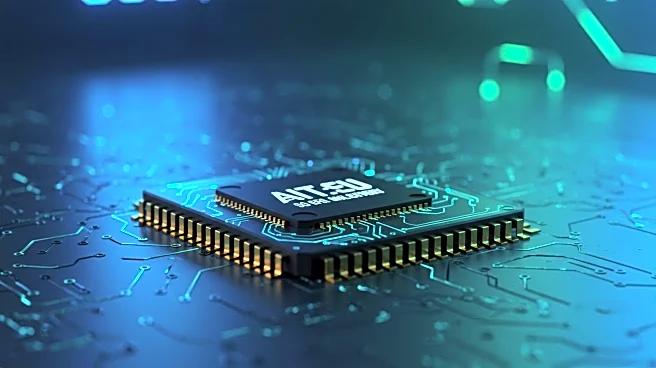What's Happening?
Nvidia, a U.S. chip company, is reportedly developing a new AI chip for the Chinese market, named B30A, which is expected to outperform its current H20 model. The B30A chip will feature a single-die design, integrating all major components onto one piece of silicon, and will include high-bandwidth memory and NVLink interconnect for improved speed and connectivity. This development comes as Chinese authorities have discouraged the use of the H20 chip in government and security-related projects, instructing major firms like Alibaba, ByteDance, and Tencent to pause H20 purchases during a national security review. The U.S. government recently eased restrictions on the export of the H20 chip to China, and Nvidia and AMD have agreed to pay the U.S. government 15% of the revenue from the sale of H20 and MI380 chips as a condition for obtaining export licenses.
Why It's Important?
The development of the B30A chip by Nvidia highlights the ongoing U.S.-China tech competition, particularly in the semiconductor industry. As China seeks to reduce its dependence on foreign semiconductors, the move underscores the geopolitical and security pressures influencing technology trade between the two nations. The agreement by Nvidia and AMD to pay a percentage of their revenue to the U.S. government reflects the complex dynamics of trade restrictions and technological advancement. This situation impacts U.S. companies seeking to maintain their market presence in China while navigating regulatory challenges. The broader implications include potential shifts in global semiconductor supply chains and the strategic positioning of U.S. tech firms in international markets.
What's Next?
As China continues to push for more domestically produced chips, U.S. companies like Nvidia may face increased pressure to adapt their strategies to align with Chinese regulatory requirements. The development of the B30A chip could lead to further negotiations between U.S. and Chinese authorities regarding technology exports and national security concerns. Additionally, the evolving landscape may prompt other U.S. tech firms to explore similar agreements or innovations to maintain their competitive edge in the Chinese market. Stakeholders, including political leaders and industry groups, will likely monitor these developments closely, considering their implications for international trade and technology policy.
Beyond the Headlines
The situation raises ethical and legal questions about the balance between national security and technological innovation. As countries prioritize domestic production of critical technologies, the potential for increased protectionism and trade barriers could affect global collaboration in tech development. Long-term shifts may include changes in how countries approach technology regulation and the role of government in shaping industry standards. The focus on domestic chip production in China also highlights the cultural and strategic importance of technological self-sufficiency in the context of international relations.















